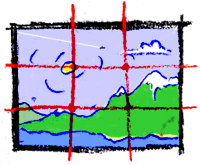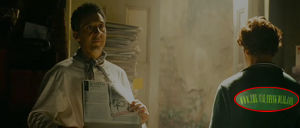 The “Rule of Thirds” dates back as far as the 18th century, defined as a guideline to help artists compose esthetically pleasing art. It encourages images to be composed in such a way as to best keep the eye flowing naturally from one point of interest to another.
The “Rule of Thirds” dates back as far as the 18th century, defined as a guideline to help artists compose esthetically pleasing art. It encourages images to be composed in such a way as to best keep the eye flowing naturally from one point of interest to another.
The Rule of Thirds can apply to more than just visual composition, however. It’s also applicable as a guideline for effective storytelling.
In visual composition, subjects in images are best positioned over any of the four central intersection points. Linear elements (such as horizons or trees, for example) should also be positioned with the horizontal or vertical lines.
Research has shown that the most natural balance of content and flow is achieved when following this composition because these lines and intersections are the areas to where the eye most naturally gravitates when wandering a scene. When the points of interest in an image are in line with these areas, a natural harmony and balance is achieved. However, there are also times when it may be better to intentionally break this rule for various reasons. Consequently, this ‘rule’ is better considered a compositional guideline.
Telling stories
As a photographer at heart, what makes photography so enticing to me is its ability as a medium to tell stories. A picture is worth a thousand words, as the saying goes. Any professional photographer will tell you that a good photograph needs to tell a story. Photos that stand out from others do so because they don’t just put a subject on display – photographers incorporate the surrounding environment, the subject’s context as a way to enhance it. This is done most effectively by either abiding by, or intentionally breaking the Rule of Thirds when composing the photo.
Like a dance, the Rule of Thirds essentially creates an imbalance by shifting weight, moving off center and leaving it to the participant to seek out a balance. This effectively generates an opportunity for them to willingly engage in the experience.
Visually, eye motion within an image is proportionate to viewer interest: as long as the eye is moving over the image, it’s interesting, and the viewer has more opportunity to respond emotionally to the artist’s composition. As a result, if you change how the eye moves, you can play with the emotions of the viewer. A compositional imbalance for example can lead to feelings of tension and uncertainty. This is why the Rule of Thirds is so significant in photography and art.
Next, let’s look at some standard story-telling tips and how they may be influenced by the Rule of Thirds.
Show, don’t tell.
From grade school, we’re taught that when writing a story, we shouldn’t describe everything in extreme detail. An author should leave room for the reader’s imagination to fill in the blanks, not words.
A good story doesn’t simply talk about a subject, but rather invites the audience to enhance it with their own imagination, participating in the story by filling in gaps and personalizing the experience. Ask two people who read the same novel, and their visualizations of the same scene may be completely different, because their individual imaginations filled in the gaps.
In photography, if the subject is dead center, it can feel as though we’re being told, almost forcefully “This is the point of interest — look at it!” But by visually shifting the subject off center, the photographer is inviting the eye to wander around the rest of the image as it naturally seeks an explanation for what it sees and why, to find a meaningful balance. Will the viewer end up satisfied, following a composition that’s pleasing to the eye? Or will they be left feeling cut off, with empty voids or questions that remain unanswered, feeling discomfort because the imbalance wasn’t resolved? We’ve all, for instance, experienced that badly composed portrait or group photo.
If the subject shifted off-center, the creator is now asking the participant to find meaning in the remaining space, to explore and examine other elements, and form for themselves a story that frames the subject, based on what’s been provided by the artist. Additionally, by giving up that level of control, the audience may not even end up having the experience that the creator was intending, because the experience was voluntarily individualized. In the context of an ARG, this may have the effect of story content being created by the participant which wasn’t predicted by the creator, to which the creator may respond in turn. One might say the creator and participant just pulled off a spontaneous dance move!
This search for balance could also be demonstrated in ARGs by allowing players themselves to locate story elements, rather than pushing them out. For example, in today’s culture one might expect any average company to own a website. We see the effect of this cultural expectation in TV and movies more often today.
 On TV a viewer may see a company or website shown only for a split second on the side of a passing vehicle, or perhaps in an ARG the subject at the moment is an email from a character that mentions the name and website of a company. Rather than being told what to do, a brief imbalance is created, and the participant may voluntarily seeks a balance. Many will curiously check for the website on the internet. There’s a euphoric moment of discovery if they’re rewarded with additional story content. Likewise if there’s no closure or resolution to the curiosity, no balance, they’re left with a reinforced sentiment that the company – and story – is entirely fictional, and they remain simply an observer. An opportunity for greater interest and involvement is lost and the experience is limited to only of what they’re told.
On TV a viewer may see a company or website shown only for a split second on the side of a passing vehicle, or perhaps in an ARG the subject at the moment is an email from a character that mentions the name and website of a company. Rather than being told what to do, a brief imbalance is created, and the participant may voluntarily seeks a balance. Many will curiously check for the website on the internet. There’s a euphoric moment of discovery if they’re rewarded with additional story content. Likewise if there’s no closure or resolution to the curiosity, no balance, they’re left with a reinforced sentiment that the company – and story – is entirely fictional, and they remain simply an observer. An opportunity for greater interest and involvement is lost and the experience is limited to only of what they’re told.
Know what your subject is
In composing a photograph, the intended subject matter should be considered. Is this a picture of the Eiffel Tower? Or is it the BIG Eiffel Tower? In this case instead of taking a simple picture of the tower, one might have a friend wave down from a walkway halfway up. This effectively shifts the intended subject out of central focus, but enhances it with environmental context. Its simple existence is now contrasted by other elements in the composition and evokes a very different feeling for the viewer.
In writing, a good example of this may be character flaws. Imperfections can cause the audience to wonder why a character is the way they are. What happened to make them react a certain way or say something the way they did? Instead of answering those questions directly, simply having the subject feel even slightly off balance can have the desired effect of engaging audience imagination, making the character more interesting and mysterious, less flat and predictable. As long as those questions or flaws remain unresolved or unqualified, the audience is intentionally left feeling very uncomfortable about the character, potentially seeking out their own explanations.
Foreshadowing, and side stories
If the subject of a composition is no longer central, it’s often balanced by environment, negative space, or some other subject or element. This provides opportunity to come at the subject from other angles. Can secondary subjects offer openings to tell tangential stories, hint at other content, or take different perspectives into the story of the primary subject?
The photo of the Eiffel Tower with a friend waving from a walkway halfway up may be a lead to another photo – captured just off to the side is a very, very long nearby stairway that the friend walked up. The next photo then shows just the friend on that stairway, collapsed playfully in exhaustion. All of this enhances and takes place within the context of the BIG Eiffel Tower.
By shifting the subject off center, additional compositional elements can lead to optional side-stories, creating a depth that wasn’t initially provided – all prompted and discovered by the participant’s desire for balance.
World-building
When taking pictures, it’s easy to answer the What? question by simply pointing at what you want to capture in a frame and snapping a shot. It’s harder to compose an image that not only answers What?, but also subversively asks Why?, inviting the viewer into the composition, evoking emotions, seeking answers, and keeping them interested in the story being told, potentially spanning multiple photos.
Likewise, it’s easy to tell a story. It’s far more work to provide the elements needed for your audience to willingly build the world in which your story takes place, or even to dynamically create and alter it in partnership with your audience.
If the philosophy of the Rule of Thirds is applied effectively in storytelling and the audience is invited to participate in this dance, a deeper connection can be made to create an environment in which the dance takes place – a world begins to take shape in which stories can be more than observed, but experienced.
—-
Update 8/31/10: Gamasutra has published a similar article discussing art techniques used in game design, including the Golden Ratio. Read here.

